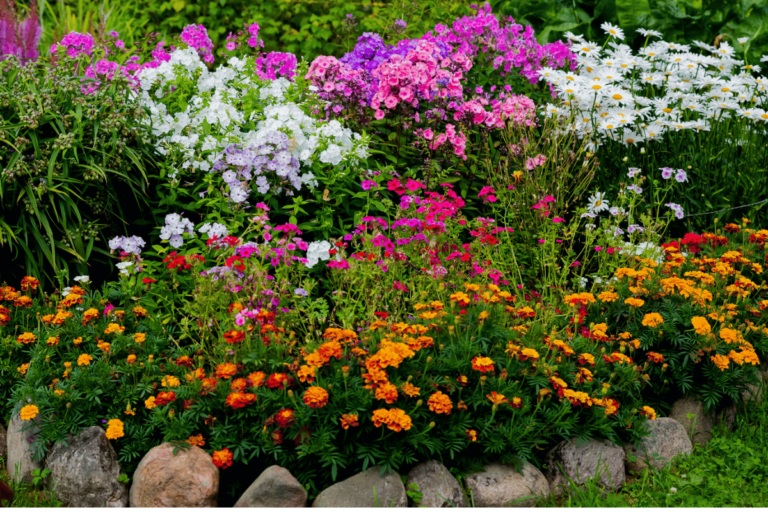Top perennial recommendations
Perennials are very useful to gardeners who want flowers that do not require much effort, last for long and come back every year. Here are some of the top perennials known for their toughness, bright colouring and long blooming periods.
Daylilies (Hemerocallis): Daylilies are versatile perennials with abundant colourful blossoms throughout summer. They grow well in various soil types and require little attention, making them popular among gardeners.
Example: The famous ‘Stella de Oro’ has golden yellow flowers and blooms several times yearly.
Peonies (Paeonia): Peonies have large, fragrant flowers and lush foliage. They flower late spring through early summer and can live up to decades if properly cared for.
Example: Sarah Bernhardt is a classic variety with pale pink double flowers.
Black-eyed Susans (Rudbeckia): Black-eyed susans are cheerful perennials with bright yellow petals and dark centres. They tolerate drought and attract pollinators, which makes them valuable to any garden.
Example: The widespread variety Goldsturm is famous for its sturdiness and beauty at full bloom.
Lavender (Lavandula): Lavender is an aromatic perennial plant that bears spikes of purple flowers during summer. It thrives in dry, sunny positions primarily because of its soothing fragrance.
Example: Hidcote is dense lavender with deep purple flowers and silver leaves surrounding it like a cloud or foggy day on the sea or landscape’s background.’
Tips On How To Take Care Of Perennial Flowers
To keep your perennial flower beds healthy for years to come, follow these care tips:
Selecting the proper planting area: Choose an appropriate site with the right soil conditions and light levels your perennials need. Most perennials prefer well-drained soil and full sun, although some cultivars will do well in partial shade.
Example: Shade-loving plants are hostas and ferns, while coneflowers and salvia need sunny conditions.
Preparing the Soil: Add compost or organic matter to improve soil structure and fertility. Perennials should be planted at the proper depth with the crown at the soil surface level. Fully water thoroughly after planting to help establish the roots.
Example: Include compost or aged manure to improve soil structure and fertility.
Mulching: Mulch around the bases of plants helps conserve moisture, suppress weeds, and regulate temperature. Apply 2-3 inch layer of organic mulch, for instance, wood chips or straw, but avoid piling up against plant stems.
Example: Put mulch in place during spring to keep moist throughout the growing season, thus minimizing weed growth.
Watering: To maintain adequate moisture levels, water perennials often, especially in dry periods. Most perennials require about one inch of water each week. Deep watering encourages profound root growth for drought tolerance.
Example: Use a soaker hose or drip irrigation system for direct water delivery into the root zone
Fertilizing: Feed plants in spring using balanced slow-release fertilizers for healthy growth and abundant blooms. Over-fertilization should be avoided since this could lead to lots of foliage without flowers.
Example: A 10-10-10 fertilizer offers an even supply of necessary nutrients.
Pruning And Deadheading: Removing spent flowers allows continuous blooming rather than letting them go into seed production. In fall or early spring, cut back foliage and tidy up the garden, removing any diseased leaves or dead ones, for that matter.
Dividing: To maintain their vigour and promote healthy growth, divide your overgrown perennial plants after some years. Divide the early spring or autumn clumps into smaller slices with a sharp spade or knife. Replant them and water them thoroughly at the same depth.
Example: Divide hostas and irises every 3-4 years to prevent overcrowding and rejuvenate the plants.
Follow these tips to enjoy your garden’s lovely and reliable perennial flowers yearly. In addition, perennials provide long-lasting blooms that improve the structure and diversity of your garden and create a dynamic, sustainable outdoor space.
Explore More Gardening Tips and Ideas
- Growing Bonsai: Tips for Miniature Tree Enthusiasts
- Buying Bonsai: Tips for Selecting Your Perfect Tree
- Bonsai Potting: Essential Tips for Tree Care Success
- Bonsai Maintenance: Essential Care for Tiny Trees
- Mastering the Art of Shaping Bonsai: A Beginner’s Guide
Source: Perennial Flowers For Your Garden


